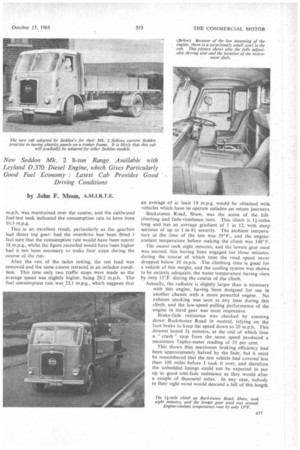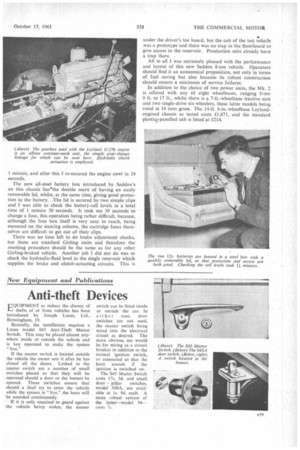Comprehensive Specification
Page 70

Page 71

Page 72

Page 73

If you've noticed an error in this article please click here to report it so we can fix it.
but Small Appetite
by John F. Moon, A.M.I.R.T.E. PARTICULARLY good fuel economy, good driving conditions and a low unladen weight in view of its comprehensive specification distinguish the new Seddon Mk. 2 8-tonner, a full description of which appeared on page 256 of the September 22, 1961 issue of The Commercial Motor. Carrying a test load of 7 tons 171 cwt., a Leyland-engined 14-ft. 6-in.-wheelbase model with a 20-ft. platform body returned no less than 16.3 m.p.g. at an average speed of 27.7 m.p.h. over a none-too-easy test route, whilst unladen the fuel consumption improved to 22.1 m.p.g. at 29.2 m.p.h. over the same course.
Rarely is this sort of economy obtainable from any genuine 8-tonner, irrespective of price, which suggests that the recently introduced Leyland 0.370 diesel which powered the test vehicle is going to prove appreciably more economical to operate than either the 0.350 or the 0.375 engines, which had previously been used in vehicles of this payload capacity.
Acceleration and hill-climbing were also commendable, whilst the new Seddon cab and the layout of its controls provided good driving conditions, roominess being a particular asset, this impression being enhanced by the diminutive engine cowl made possible by the low engine mounting.
The test vehicle, although an early production model. had a perfectly standard specification, only the telescopic dampers at the front axle being listed as optional equipment. The Leyland 0.370 engine drove through the basic Albion five-speed constant-mesh gearbox and two-piece propeller shaft into the Seddon hypoid-bevel rear axle, which had the standard 6.16-to-1 reduction ratio. The latest standard plastics-panelled cab was fitted, and the 20-ft. body was a Seddon assembly with timber underframing, flooring and headboard, and angle-iron rave rails.
Ready for the road the fully equipped 8-tonner was found to weigh 4 tons 11 cwt., and with Seddon's Frank Galbraith, myself and test equipment aboard the vehicle grossed 12 tons 24 cwt. after the test load had been added.
Brake tests were carried out first, and the stopping distances recorded from both 20 and 30 m.p.h. were almost the same as those obtained with a Seddon-7-tonner running at nearly 1 ton lighter, the test report of which appeared in our issue of September 30, 1960. The braking was B36 The 8-tanner's acceleration performance, both through the gears and in direct drive, was above average for a vehicle of this weight. For the standing-start tests, second, third, fourth and top gears were employed, top only just being necessary because 29 m.p.h. can be reached in fourth gear. The top-gear maximum is 42 m.p.h., which can be increased to well over 50 m.p.h. with the optional overdrive ratio available on the Albion box.
The engine pulled smoothly from as low a speed as 8 m.p.h. during the direct-drive acceleration tests, and the very flat torque curve of this Leyland unit produced consistent acceleration between 10 and 20 m.p.h. and between 20 and 30 m.p.h. No transmission roughness was noticed during this test.
A six-mile out-and-return fuel-consumption test was made along The Broadway, Chadderton, a route involving plenty of gear changing because it contains six sets of traffic lights and one roundabout. Nevertheless, without exceeding 33 m.p.h. at any time, an average speed of 27.7 m.p.h. was maintained over the course, and the calibrated fuel-test tank indicated the consumption rate to have been 16.3 m.p.g.
This is an excellent result, particularly as the gearbox had direct top gear: had the overdrive box been fitted I fed sure that the consumption rate would have been nearer 18 m.p.g., whilst the figure recorded would have been higher had it not been necessary to make four stops during the course of the run.
After the rest of the laden testing, the test load was removed and the same course retraced in an unladen condition. This time only two traffic stops were made so the average speed was slightly higher, being 29.2 m.p.h. The fuel consumption rate was 22.1 m.p.g., which suggests that an average of at least 19 m.p.g. would be obtained with vehicles which have to operate unladen on return journeys.
13uckstones Road, Shaw, was the scene of the hillclimbing and fade-resistance tests. This climb is 11-miles long and has an average gradient of 1 in 12, with steep sections of up to 1-in-84 severity. The ambient temperature at the time of the test was 59°F., and the enginecoolant temperature before making the climb was 148°F.
The ascent took eight minutes, and the lowest gear used was second, this having been engaged for three minutes, during the course of which time the road speed never dropped below 10 m.p.h. The climbing time is good for a vehicle of this weight, and the cooling system was shown to be entirely adequate, the water temperature having risen by only I5°F. during the course of the climb.
Actually, the radiator is slightly larger than is necessary with this engine, having been designed for use in another chassis with a more powerful engine. No exhaust smoking was seen at any time during this climb, and the low-speed pulling performance of the engine in third gear was most impressive.
Brake-fade resistance was checked by coasting down Buckstones Road in neutral, relying on the foot brake to keep the speed down to 20 m.p.h. This descent lasted 31 minutes, at the end of which time a " crash " stop from the same speed produced a maximum Tapley-meter reading of 33 per cent.
This shows that maximum braking efficiency had been approximately halved by the fade, but it must be remembered that the test vehicle had covered less than 100 miles before I took it over, and therefore the unbedded linings could not be expected to put up as good anti-fade resistance as they would after a couple of thousand miles. hi any case, nobody in their right mind would descend a hill of this length in neutral, and despite all this there was still 4 in, of pedal travel left at the bottom of the hill.
I then drove the Seddon back to the 1-in-8i section a id here I stopped it. The handbrake was powerful enough to restrain the vehicle from rolling backwards, and it was then shown possible to make a restart in second gear, although only after I had deliberately slipped the clutch for a second or two, just to get the vehicle moving. From the restart performance on this gradient it is fairly safe to judge that bottom gear should be low enough to enable restarts on gradients approaching 1-in-5 severity.
High Handling Standard The handling of the Mk. 2 reached a high standard, and the 8-tonner should not be tiring to drive over long distances. The steering is light at normal speeds, and not really heavy at walking pace, whilst there is an entirely adequate degree of castor action. All-round vision is good, large rear-view mirrors being standard equipment, and the cab layout is at the same time attractive and practical, electrical switches being mounted on " arms " extending from each side of the steering column, whilst the instrument dials are on the dashboard, immediately to the left of the steering wheel.
Both laden and unladen the 8-tonner rode well. Engine noise tended to be a little excessive, but unlike certain earlier Seddon cabs, this one does not have a plastics engine cowl (so the sound deadening effect of that is lost), 1538 and the sheet-steel cowl of the test vehicle carried no insulation material underneath it nor a quilt over it.
A few maintenance tests were carried out to assess the accessibility of those components most likely to need regular attention. A water-level check took me only 3 seconds, but checking the engine oil took 1 minute 8 seconds because the engine cowl has to be lifted and strapped back before the dipstick can be reached. The gearbox and rear-axle oil levels were checked quite easily in 52 seconds and 60 seconds respectively.
Raising the engine cowl, strapping it against the back of the cab and securing the hinged sides against the uncle side of the upper cowl section took only 14 seconds. Th' done, I then removed the paper element of the air cleanin 18 seconds and replaced it in 33 seconds. Removal 91 the paper element of the fuel filter took 55 seconds, an its replacement 70 seconds. This filter is located at th front of the cylinder head, and is much easier to work o than most.
Rocker Cover Removed Removal of an injector from this Leyland engine entai s taking off the rocker cover, a 75-second job. With th s cover off I then removed No. I injector in 1 minute seconds without difficulty. This done, I replaced the inject 'r in 1 minute 25 seconds and the rocker cover in a furth r 1 minute 20 seconds. Bleeding the fuel system at t e injection pump by hand priming at the lift pump to k
1 minute, and after this I re-secured the engine cowl in 24 seconds.
The new all-steel battery box introduced by Seddon's on this chassis has.the double merit of having an easily removable lid, whilst, at the same time, giving good protection to the battery. The lid is secured by two simple clips and I was able to check the battery-cell levels in a total time of 1 minute 30 seconds. It took me 39 seconds to change a fuse, this operation being rather difficult, because, although the fuse box itself is very easy to reach, being mounted on the steering column, the cartridge fuses themselves are difficult to get out of their clips.
There was no time left to do brake adjustment checks, but these are standard Girling units and therefore the resetting procedure should be the same as for any other Girling-braked vehicle. Another job I did not do was to check the hydraulic-fluid level in the single reservoir which supplies the brake and clutch-actuating circuits. This is • under the driver's toe board, but the cab of the test vehicle was a prototype and there was no trap in the floorboard to give access to the reservoir. Production cabs already have a trap there.
All in all I was extremely pleased with the performance and layout of this new Seddon 8-ton vehicle. Operators should find it an economical proposition, not only in terms of fuel saving but also because its robust construction should ensure a minimum of service failures.
In addition to the choice of two power units, the Mk. 2 is offered with any of eight wheelbases, ranging from 9 ft. to 17 ft., whilst there is a 7-ft.-wheelbase tractive unit and two single-drive six-wheelers, these latter models being rated at 16 tons gross. The 14-ft. 6-in.-wheelbase Leylandengined chassis as tested costs £1,671, and the standard plastics-panelled cab is listed at £214.




































































































































